Читать книгу Guided Practice for Reading Growth, Grades 4-8 - Laura Robb - Страница 12
Chapter 1 What Developing Readers Need
ОглавлениеIndependent reading needs to happen every day.
This day was a first for me! I had worked with students reading one to two years below grade level but never with students entering fifth grade reading from an early first to second grade level. Most had never read a book; they listened to teachers read books aloud and worked on computer reading programs. To bring these fifth graders into the reading life, I knew they had to read, read, read, because volume would be key to their progress. Even though teachers had a daily 60-minute ELA class, it wasn’t enough time to change many students’ reading trajectories because there were 24 students reading from kindergarten to sixth grade instructional levels.
To solve the problem of time, the fifth grade team at Daniel Morgan Intermediate School in Winchester, Virginia, lobbied for an extra class. In January, the district funded a daily 73-minute class for 24 students reading from an early first to beginning third grade level; Stacey Yost, Bridget Wilson, and I team-taught the class. During the 15−20 minutes of guided reading, I supported the six English language learners (ELL) students reading at a beginning first grade level. They had been in the school system since kindergarten and spoke English well. But they couldn’t read.
At our first meeting, I asked the group, “How do you feel about reading?” No responses. I followed up with two questions: “Do you enjoy listening to teachers read aloud? Do you have a favorite book you’ve listened to?” Still, no one shared. Eyes focused on the table, they avoided looking at me. During the remaining time I started reading aloud, I Can Be Anything! Don’t Tell me I Can’t by Diane Dillon (2018). Students’ silence, shrugging of shoulders, and quizzical looks when I asked them to share their dreams told me that their hopes-and-dreams tanks were on empty.
The next day, during guided reading I asked, “Why do you think it’s important to learn how to read?” And Kendra blurted, “So others don’t make fun of us!” Silence. Nods of agreement—a door had opened. Three of the six students shared their feelings that day. They talked about times they had to read aloud and classmates laughed as they stumbled through a short passage or times when they couldn’t answer a question because they couldn’t read and understand the material.
After each class Stacey, Bridget, and I discussed what we had learned from students. Most carried negative reading baggage and covered up their lack of progress by checking out, from the school’s library and our class library, books they couldn’t read. They were desperate to look like grade level readers and avoid the comments about having to read baby books from peers.
How to choose a good fit book was a lesson Stacey, Bridget, and I repeated several times a week. We took turns modeling for students (see box). Six weeks later, we noticed some students selecting books they could read and enjoy. We celebrated these changeovers and gave students the gift of time they needed to choose books they could read and enjoy.
How to Teach Students to Choose a Good Fit Book
Think aloud and show what you feel and think when you choose a book that is too difficult: can’t say many words, don’t know many word meanings, and can’t recall details.
Think aloud to model how you know you’ve found a good fit book: it’s easy to read, enjoyable, and you can retell.
Keep modeling and emphasize that independent reading should be enjoyable.
Reassure students that they are safe in your class and can select a book they can easily read. Explain that the more they read accessible books, the faster their reading will improve.
Daily, the three of us took turns sharing this mantra during guided reading and when we modeled how to choose a good fit book: In this class you are safe. No one will make fun of you or criticize you. We are here to learn together and support one another. It might seem like a small thing. But for these students who lived with failure for such a long time, we hoped that by repeating these words, combined with their reading successes, students’ self-confidence and trust in our community would continually improve.
We became dedicated kid-watchers and listeners, eager to learn as much as we could about our developing readers (Owacki & Goodman, 2002). We met frequently to share literacy stories and what we noticed during daily interactive read-alouds. Observations of and conversations with students continually deepened our knowledge of their feelings and beliefs about learning to read.
